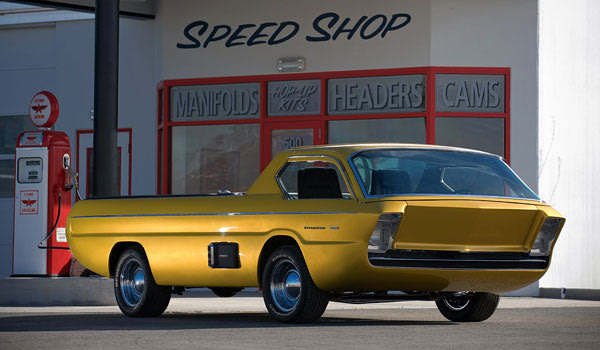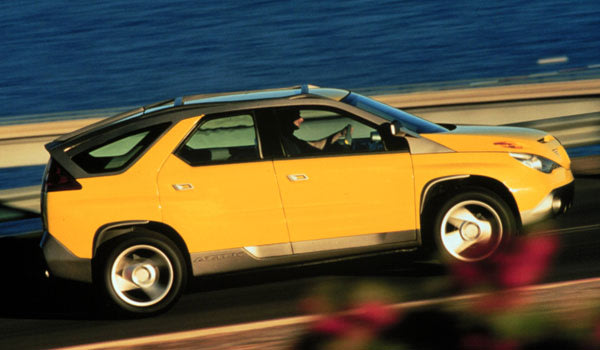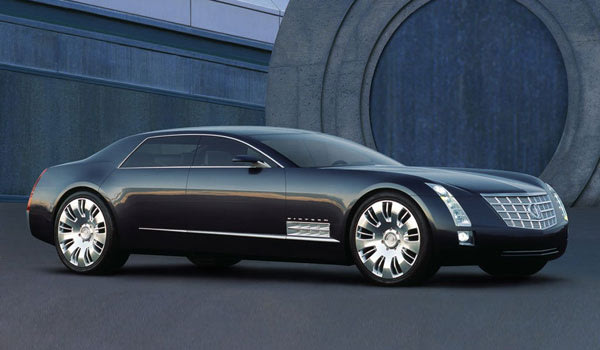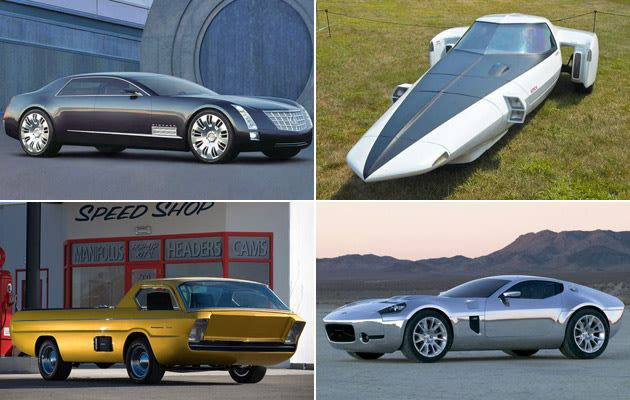
Concept cars are staples at major auto shows, but the cars typically look much different if and when they make it to production. In many cases, that's a mistake. Here are 11 times when changing a concept car, or failing to put it into production at all, was a big mistake.
1973 Chevrolet AeroVette Concept
If one thing had changed back in the early 1970s, today's Corvette would be midengine.
In 1969, Zora Arkus-Duntov (the father of the Corvette) built the experimental XP-882, a midengine Corvette concept. Unfortunately, John DeLorean, then Chevrolet's general manager, put the project on hold. To blunt the media impact of Ford's introduction of the midengine Pantera, DeLorean authorized a refurbishment of the XP-882 in 1972. The car emerged as the XP-895, with its transverse V-8 replaced by a four-rotor Wankel engine producing 420 hp.
While GM scrapped its rotary development program in 1973, the idea of a midengine Corvette was well received. Nevertheless, the Corvette remained front-engine/rear-drive for cost reasons. Had the midengine XP concept made production, then Corvette today would be perceived as a more apt competitor to Ferrari and Porsche.
2003 Dodge Tomahawk
With a vibe that would be at home on the set of Blade Runner, the outrageous Viper-powered Tomahawk represents the best and worst of concept cars.
Concepts are at their worst when, like the Tomahawk, they are completely nuts. Had Chrysler ever seriously considered building this thing, its lawyers would have killed the project out of fear the public would find out the company's leaders had all lost their minds.
But put your pragmatism to the side for a second and consider this: The Tomahawk's 8.3-liter V-10 makes 500 hp. Theoretically, the engine running through a two-speed gearbox could power the 1500-pound bike to 60 mph in just 2.5 seconds, with a max of around 300 mph.
Still, given that Nissan is producing a limited number of Juke Rs, it's clear that there's a niche market out there for crazy. Are you listening, Chrysler?
1967 Dodge Deora Concept
The very first run of Hot Wheels included a golden-colored futuristic pickup called the Deora. While the truck looked like a fanciful rendering by a toy-car designer, it was, in fact, a scale model of a real vehicle.
Built in Detroit by the famous Alexander brothers (Mike and Larry, who also helped Chili Catealo with the famous Little Deuce Coupe), the Deora was based on a Dodge A100 cab-over van, and powered by a 101-hp 170-cubic-inch Slant-6 engine. Dodge promoted the Deora as a futuristic pickup concept. We're still waiting.
1969 Chevrolet Astro III Concept
To truly appreciate GM's Astro III concept, you've got to view it through 1969 eyes. NASA's space program was the envy of the world, having reached the moon. Transistors were replacing tubes in radios and jets were replacing prop-driven commercial aircraft. High-tech and space age reigned.
The sleek, gas turbine–powered 1969 Chevrolet Astro III two-seater foreshadowed alternative powertrains and advanced automotive technology. The turbine weighed just 139 pounds but cranked out 317 hp. The wide-set rear wheels and narrow-track front wheels foresaw the DeltaWing racer by four decades. The Astro III's closed-circuit TV rearview mirrors and drive-by-wire steering also show the concept's advanced thinking, as did the powered and cantilevered forward-opening canopy.
1999 Pontiac Aztek Concept
Back in the bad old days at GM, the people in charge of vehicle manufacturing had huge control over how vehicles looked. Designers knew what they wanted GM's first crossover to look like, but in the convoluted corporate world of the 1990s, GM own manufacturing team wouldn't give it to them. The excuse? It would have cost too much.
That decision cost GM dearly... and not just in dollars.
The hideous slab-sided production horror that debuted in 2001 shares little with the 1999 concept pictured here. Their proportions are completely different. The most visible alteration was to the angular roof of the concept that looked much like the production Chevrolet Equinox.
If the concept had made it to production, the fate of the Aztek would have likely been much different. Instead, the Aztek earned its title as the ugliest car in the world, and helped kill off the Pontiac brand.
2001 Volkswagen Microbus Concept
Some vehicles just make you smile. The Microbus Concept that VW introduced at the 2001 Detroit Auto Show is one of those.
Designed (where else) at VW's surf-central design studio in Simi Valley, Calif., the Microbus took a fresh look at the 1950s original during the post-Y2K zenith of minivan popularity in North America. The airy exterior looks comfortable riding on its 20-inch rims. Running gear was off-the-shelf VW engine with a 3.2-liter narrow angle V-6. Inside, the pleasingly retro interior creates a completely modern and functional space.
The fact that VW developed such a great concept makes the retail reality of the EuroVan and Routan that much more disappointing. We believe the Microbus Concept was a significant missed opportunity, and maybe VW thinks this too? They introduced a second bus concept in 2011 known as the Bulli. Hope springs eternal... just like wildflowers.
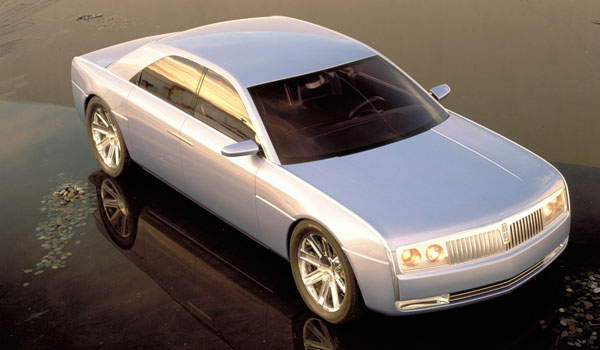
2002 Lincoln Continental Concept
Few cars have aged as gracefully as the 1961–63 Lincoln Continental. The sedan's clean, restrained lines became an icon of modern design and defined Lincoln style for decades.
The 2002 Lincoln Continental Concept that debuted at the Los Angeles Auto Show in January 2002 proved that somebody at Lincoln still knew something about style and heritage. Clean lines? Check. Suicide doors? Check. Immediately recognizable as a Lincoln but not egregiously retro? Check.
But in the two weeks that separated the car's L.A. show debut and the Detroit Auto Show, Ford Motor Company announced the results of one of its many restructuring plans: The production Continental was canceled, making the concept a PR nightmare. For the Detroit show, the freshly estranged concept was shunned. It spent the auto show parked in a dark corner of the Lincoln display area.
2005 Ford-Shelby GR-1 Concept
The fantastic Ford GT went out of production in 2006, leaving Ford without a genuine supercar in its portfolio. The GR-1 could have been that car. A 6.4-liter, 605-hp V-10 powers the sinewy silver coupe that was inspired by the 1964 Shelby Daytona coupe. The highly polished aluminum body heralds its naked finish proudly.
Back in the day, Ford's design chief J. Mays opined that the company could afford to build the GR-1 thanks to its extensive use of Ford GT parts. But no such luck—the car never went into production.
While the 2013 Shelby GT-500 is a wonderful, powerful car, a supercar it's not. Ford: Even with Mr. Shelby's passing, you could still build this car.
2008 Toyota A-BAT Concept
Trucks keep getting bigger. Fuel prices remain high. What truck lovers the world over need is a capable, small pickup—something akin to the mini trucks of the 1970s and '80s.
Toyota created just such a concept with the 2008 Toyota A-BAT concept truck. It's difficult to judge the size of the A-BAT from a photo, but with an overall length of just 181.3 inches, it measured a foot shorter than a typical midsize sedan. The lightweight, compact truck used the gas–electric hybrid drive system from the Toyota Prius.
To give such a small vehicle good hauling capacity (and let it carry items longer than 90 inches), the A-BAT had a deep pickup-style box and a midgate that opened a clear passageway between the cab's interior and the exterior bed (a la the Chevrolet Avalanche).
This is one of those "What are you waiting for" ideas.
2003 Cadillac Sixteen
Corporate schizophrenia can clearly be seen in the fact that ex-GM design chief Wayne Cherry was responsible for both the production Pontiac Aztek and the Cadillac Sixteen luxury-sedan concept seen here.
Designed to spearhead Cadillac's phoenixlike rise from the design and sales abyss, the Sixteen evokes Cadillac's heritage in a modern manner with 24-inch tires, a super-luxurious cabin for four, an all-glass roof, invisible B-pillars, and extensive use of real crystal for both interior and exterior decor. Under its gullwing hood purrs a V-16 engine displacing 13.6 liters and producing an incredible 1000 horsepower and 1000 lb-ft of torque.
Caddy never produced the bombastic Sixteen, but much like the 1938 Buick Y-Job inspired vehicles that followed it, you can see the Sixteen's influence all over the current crop of Cadillacs. Maybe we'll see such a car from Cadillac someday, though in the current fuel-conscious climate that engine would come down in size dramatically.
1938 Buick Y Job
Concept cars have been a mainstay of automotive design and marketing for more than a century. While Henry Leland's Osceola is considered the world's first concept car that actually made it into production, the 1938 Buick Y Job is another early example of a true concept car.
Built under the direction of General Motors' first design director, Harley Earl, the Y-Job was never intended for production but instead foreshadowed the styling and engineering cues Earl and his team hoped to use on future GM vehicles. In its day, the Y-Job earned praise for its modern style that included integrated fenders, hidden headlamps, and no running boards. The positive reaction helped several of its design cues to make it into production, including the stubby tail fins that would appear on the iconic 1948 Cadillacs and the grille design that continues to influence Buick design.
Although the Y-Job didn't make production, it remains an example of the good a concept car can do for a company and the industry. We can't help but wonder what would have happened, though, if Buick put the Y-Job into production. The company would have been in an even better position postwar. LINK


